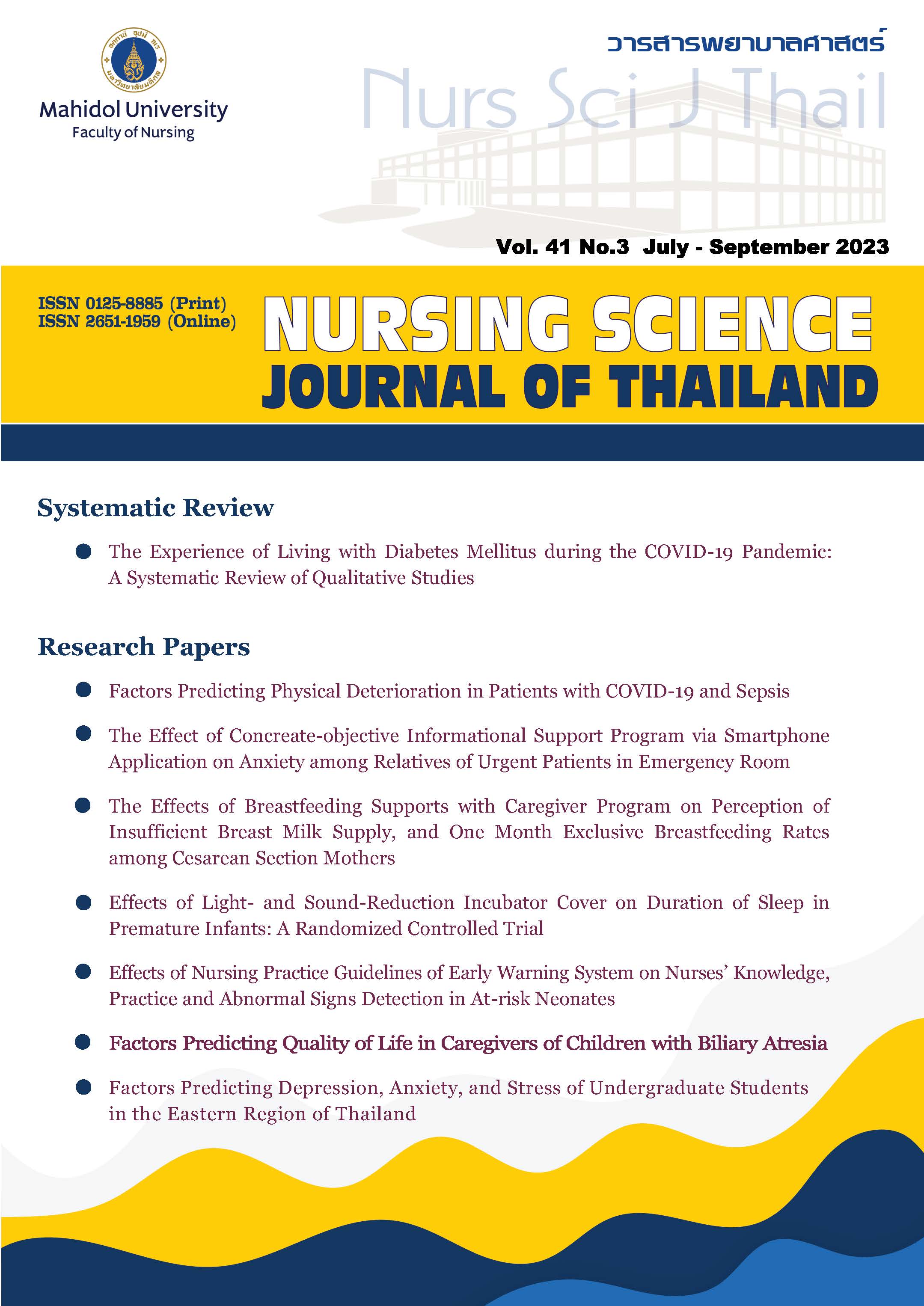ผลของโปรแกรมการสนับสนุนด้านข้อมูลแบบรูปธรรม-ปรนัยผ่านแอปพลิเคชันบนสมาร์ตโฟน ต่อความวิตกกังวลของญาติผู้ป่วยเร่งด่วนในห้องฉุกเฉิน
Main Article Content
บทคัดย่อ
วัตถุประสงค์: เพื่อศึกษาผลของโปรแกรมการสนับสนุนด้านข้อมูลแบบรูปธรรม-ปรนัยผ่านแอปพลิเคชันบนสมาร์ตโฟนต่อความวิตกกังวลของญาติผู้ป่วยเร่งด่วนในห้องฉุกเฉิน
รูปแบบการวิจัย: การวิจัยกึ่งทดลอง
วิธีดำเนินการวิจัย: กลุ่มตัวอย่างเป็นญาติของผู้ป่วยเร่งด่วนที่มารับบริการที่ห้องฉุกเฉินจำนวน 84 ราย แบ่งเป็นกลุ่มทดลอง 42 ราย และกลุ่มควบคุม 42 ราย กลุ่มทดลองได้รับโปรแกรมการสนับสนุนด้านข้อมูลแบบรูปธรรม-ปรนัยผ่านแอปพลิเคชันบนสมาร์ตโฟนและกลุ่มควบคุมได้รับการพยาบาลตามปกติ และหลังจากผู้ป่วยเข้าไปในห้องฉุกเฉินเป็นเวลา 90 นาที ทั้งสองกลุ่มจะได้เข้าเยี่ยมผู้ป่วย 5 นาที เก็บข้อมูลโดยใช้แบบสอบถามข้อมูลส่วนบุคคลของผู้ป่วยและญาติ แบบประเมินความวิตกกังวลขณะเผชิญ แบบประเมินความวิตกกังวล และแบบประเมินความพึงพอใจต่อการสนับสนุนด้านข้อมูลผ่านแอปพลิเคชัน วิเคราะห์ข้อมูลโดยใช้สถิติไคสแควร์ สถิติทดสอบที และสถิติวิเคราะห์ความแปรปรวนเมื่อมีการวัดซ้ำ
ผลการวิจัย: กลุ่มทดลองมีคะแนนความวิตกกังวลหลังได้รับโปรแกรมและหลังเข้าเยี่ยมผู้ป่วย ต่ำกว่าก่อนการทดลองอย่างมีนัยสำคัญทางสถิติ (p < .001) หลังได้รับโปรแกรมฯ ความแตกต่างของคะแนนความวิตกกังวลระหว่างก่อนและหลังได้รับโปรแกรมในกลุ่มทดลองมีมากกว่าคะแนนความแตกต่างในกลุ่มควบคุมอย่างมีนัยสำคัญทางสถิติ (p < .001) อย่างไรก็ตาม หลังเข้าเยี่ยมผู้ป่วย ความแตกต่างของคะแนนความวิตกกังวลระหว่างก่อนและหลังเข้าเยี่ยมผู้ป่วยไม่แตกต่างกัน (p > .05) นอกจากนี้ ค่าเฉลี่ยคะแนนความวิตกกังวลขณะเผชิญหลังเข้าเยี่ยมผู้ป่วยในกลุ่มทดลองและกลุ่มควบคุมไม่มีความแตกต่างกัน (p > .05)
สรุปและข้อเสนอแนะ: โปรแกรมการสนับสนุนด้านข้อมูลแบบรูปธรรม-ปรนัยผ่านแอปพลิเคชันบนสมาร์ตโฟนสามารถลดความกังวลของญาติผู้ป่วยเร่งด่วนในขณะรออยู่นอกห้องฉุกเฉินได้ พยาบาลควรนำโปรแกรมนี้ไปใช้กับประชากรกลุ่มเป้าหมายในการปฏิบัติพยาบาลตามปกติ
Article Details

อนุญาตภายใต้เงื่อนไข Creative Commons Attribution-NonCommercial-NoDerivatives 4.0 International License.
ลิขสิทธิ์: วารสารพยาบาลศาสตร์เป็นเจ้าของลิขสิทธิ์ในการเผยแพร่ผลงานที่ตีพิมพ์ ห้ามผู้ใดนำบทความที่ได้รับการตีพิมพ์ในวารสารพยาบาลศาสตร์ไปเผยแพร่ในลักษณะต่างๆ ดังต่อไปนี้ การส่งบทความไปตีพิมพ์เผยแพร่ที่อื่น การนำบทความเผยแพร่ออนไลน์ การถ่ายเอกสารบทความเพื่อกิจกรรมที่ไม่ใช่การเรียนการสอน ยกเว้นเสียแต่ได้รับอนุญาตจากวารสารพยาบาลศาสตร์

Disclaimer: เนื้อหาบทความหรือข้อคิดเห็นใดๆ ในวารสารพยาบาลศาสตร์ ถือเป็นความรับผิดชอบของผู้เขียน กองบรรณาธิการไม่จำเป็นต้องเห็นด้วยและไม่มีส่วนรับผิดชอบแต่อย่างใด
เอกสารอ้างอิง
Department of Medicine, Ministry of Public Health. Guideline for emergency room service delivery. Nonthaburi: Department of Medicine, Ministry of Public Health; 2018. 94 p. (in Thai).
Hooker EA, Mallow PJ, Oglesby MM. Characteristics and trends of emergency department visits in the United States (2010-2014). J Emerg Med. 2019;56(3):344-51. doi: 10.1016/j.jemermed.2018.12.025.
Hinson J, Martinez D, Schmitz P, Toerper M, Radu D, Scheulen J, et al. Accuracy of emergency department triage using the emergency severity index and independent predictors of under-triage and over-triage in Brazil: a retrospective cohort analysis. Int J Emerg Med. 2018;11(1):3. doi: 10.1186/S12245.017.0161.8.
Rose L, Scales DC, Atzema C, Burns KE, Gray S, Doing C, et al. Emergency department length of stay for critical care admissions. A population-based study. Ann Am Thorac Soc. 2016;13(8):1324-32. doi: 10.1513/AnnalsATS.201511-773OC.
Hsiao PR, Redley B, Hsiao Y-C, Lin C-C, Han C-Y, Lin HR. Family needs of critically ill patients in the emergency department. Int Emerg Nurs. 2017;30:3-8. doi: 10.1016/j.ienj.2016.05.002.
Yildirim T, Özlü ZK. Needs of critically ill patients’s relatives in emergency departments. Nurs Midwifery Stud. 2018;7(1):33-8. doi: 10.4103/nms.nms_100_17.
Toloo G-S, Aitken P, Crilly J, FitzGerald G. Agreement between triage category and patient’s perception of priority in emergency departments. Scand J Trauma Resusc Emerg Med. 2016;24(1):126. doi: 10.1186/s13049-016-0316-2.
Vitali R, Ficarra L, Lopresti ML. The waiting experience in the emergency room: a qualitative analysis of the patient waiting emotional state. Acta Medica Mediterr. 2013;29(1):77-82.
Mary PE, Al Grad HS. A research critique on lived-in experiences of significant others of patients admitted in emergency department at selected hospitals. International Journal of Nursing Education. 2017;9(3):23-8.
Nikki L, Lepistö S, Paavilainen E. Experiences of family members of elderly patients in the emergency department: a qualitative study. Int Emerg Nurs. 2012;20(4):193-200. doi: 10.1016/j.ienj.2012.08.003.
Forsgärde E-S, Attebring MF, Elmqvist C. Powerlessness: dissatisfied patients' and relatives' experience of their emergency department visit. Int Emerg Nurs. 2016;25:32-6. doi: 10.1016/j.ienj.2015.07.004.
Emmamally W, Brysiewicz P. Families’ perceptions of support from health care professionals in the three emergency departments in KwaZulu Natal, South Africa. Int J Afr Nurs Sci. 2019;10:55-60. doi: 10.1016/j.ijans.2019.01.004.
Spielberger CD, Gorsuch RL, Lushene R, Vagg PR, Jacobs GA. Manual for the state-trait anxiety inventory. Palo Alto, CA: Consulting Psychologists Press; 1983. 36 p.
Avci S, Deniz AE, Buyukcam F. State and trait anxiety of patients’ relatives in the emergency department. Revista Argentina de Medicina. 2017;5(3):190-6.
Lukmanulhakim, Suryani, Anna A. The relationship between communication of nurses and level of anxiety of patient’s family in emergency room Dr. Dradjat Prawiranegara Hospital, Serang Banten, Indonesia. Int J Res Med Sci. 2016;4(12):5456-62. doi: 10.18203/2320-6012.ijrms20164228.
Ekwall A, Gerdtz M, Manias E. Anxiety as a factor influencing satisfaction with emergency department care: perspectives of accompanying persons. J Clin Nurs. 2009;18(24):3489-97. doi: 10.1111/j.1365-2702.2009.02873.x.
Patcharatanasan N, Lertmaharit S. The prevalence characteristics and related factors of workplace violence in healthcare workers in emergency departments of government hospitals in region health provider. Journal of Preventive Medicine Association of Thailand. 2018;8(2):212-25. (in Thai).
Wong LL, Ooi SB, Goh LG. Patients' complaints in a hospital emergency department in Singapore. Singapore Med J. 2007;48(11):990-5.
Khowtong W, Sukonthasarn A, Wangsrikhun S. Effectiveness of caring for acute critically ill patients base on family-centered care concept in emergency department. Nursing Journal. 2019;46(2):176-87.
Papa L, Seaberg DC, Rees E, Ferguson K, Stair R, Goldfeder B, et al. Does a waiting room video about what to expect during an emergency department visit improve patient satisfaction? CJEM. 2008;10(4):347-54. doi: 10.1017/S1481803500010356.
Johnson JE. Self-regulation theory and coping with physical illness. Res Nurs Health. 1999;22(6):435-48. doi: 10.1002/(sici)1098-240x(199912)22:6<435::aid-nur2>3.0.co;2-q.
Aksornsri A, Thammapanichwat W, Wichienchareon K, Saengperm P. The effects of concrete-objective information on parental anxiety and parental participation in care for children in pediatric intensive care unit. Nursing Science Journal of Thailand. 2012;30(2):80-9. (in Thai).
Watthanasereewetch T, Chaiyawat W. The effect of providing concrete-objective information before the first visit to pediatric patients in intensive care unit on maternal anxiety. Journal of Nursing Research. 2017;18(3);91-9. (in Thai).
Dalal AK, Dykes PC, Collins S, Lehmann LS, Ohashi K, Rozenblum R, et al. A web-based, patient-centered toolkit to engage patients and caregivers in the acute care setting: a preliminary evaluation. J Am Med Inform Assoc. 2016;23(1):80-7. doi: 10.1093/jamia/ocv093.
Gaberson KB. The effect of humorous distraction on preoperative anxiety. A pilot study. AORN J. 1991;54(6):1258-64. doi: 10.1016/s0001-2092(07)66875-6.


